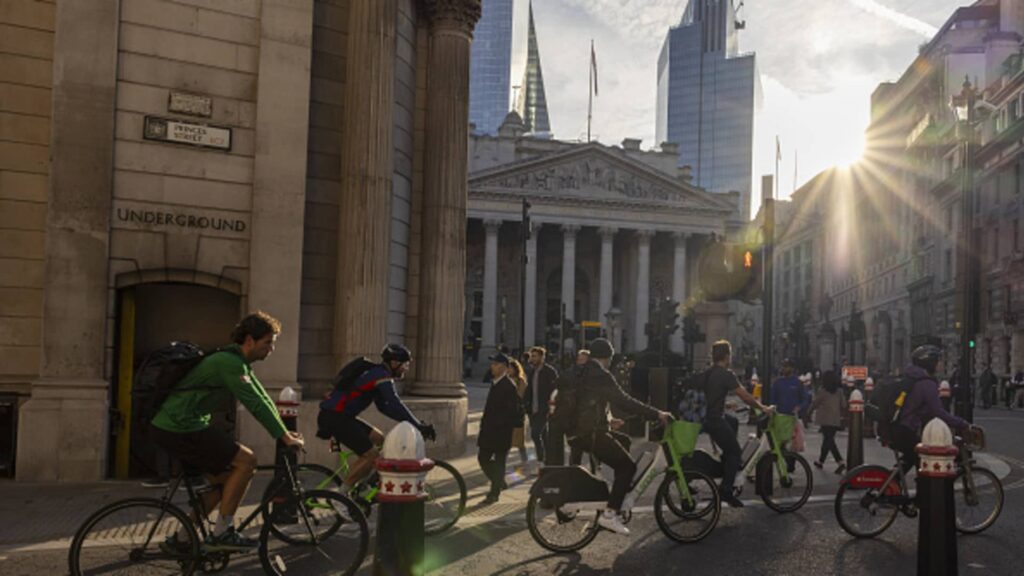Commuters cycle past the Bank of England (BOE) (left) in the City of London, England, Monday, September 16, 2024.
Bloomberg | Bloomberg | Getty Images
LONDON – The Bank of England said on Thursday it would keep interest rates steady after its first cut in August, despite the Federal Reserve opting to cut interest rates sharply the day before.
The Monetary Policy Committee voted 8 to 1 to remain unchanged, with dissenting members voting in favor of another 0.25 percentage point cut in interest rates.
The committee said “gradual” monetary easing remains appropriate and services sector inflation remains “high.” The report added that the British economy has returned to growth this year, but its performance is sluggish, and is expected to return to a basic growth rate of about 0.3% per quarter in the second half of the year.
The Monetary Policy Committee is assessing a mix of data when making its rate decision, with headline inflation staying close to the 2% target but price rises in services, which account for about 80% of the UK economy, rising to 5.6% in August. In the three months to July, wage growth in the UK fell to a more than two-year low, but remained at a relatively high level of 5.1%.
Boosted by statements from the Bank of England and the Federal Reserve, the pound rose 0.72% against the dollar to $1.3306 at 12:10 noon London time on Thursday. This is the highest rate since March 2022, according to LSEG data.
Meanwhile, global stock markets rose on Thursday, with the pan-European Stoxx 600 index rising 1.45%.
Also in the spotlight on Thursday is the Bank of England’s annual announcement on the pace of quantitative tightening (QT). The central bank voted to reduce its stock of bonds, known as government bonds, by 100 billion pounds ($133 billion) over the next 12 months through active sales and bond maturities.
The amount is unchanged from the previous period but contrary to some expectations of an acceleration in the program. The Bank of England’s balance sheet continued to swell as it sought to boost the economy during the pandemic, but then reversed course and began quantitative easing in February 2022.
The Bank of England is losing money on its taxpayer-subsidized quantitative easing program because bonds are being sold for less than they were purchased for. However, Bank of England Governor Andrew Bailey believes the central bank needs to engage in quantitative easing now to give it room to do more quantitative easing or other operations in the future.
The impact of the Federal Reserve
Even though the Federal Reserve started cutting interest rates this cycle on Wednesday by 50 basis points, the Bank of England still confirmed its expectation to keep interest rates unchanged. While markets this week are pricing in a more than 50% chance of a more aggressive approach, many strategists expect a smaller rate cut of 25 basis points at the September meeting.
Federal Reserve Chairman Jerome Powell said at a press conference that the central bank is “working toward a situation that restores price stability without the painful rise in unemployment that sometimes comes with inflation.” Recent U.S. labor market data has raised concerns about the extent of the slowdown in the world’s largest economy.
The Monetary Policy Committee’s decision is likely to be locked in around noon on Wednesday ahead of the Fed’s announcement, but central bankers around the world will now assess what the move means for global growth and financial conditions.
Ballinger Group foreign exchange analyst Kyle Chapman said the Bank of England’s 8-1 vote was “more decisive and more hawkish than expected”, supporting gilt yields and boosting the pound.
“This is a cautious decision that reflects the fact that the Bank of England is simply not as lucky as the Fed when it comes to inflation… That said, the meeting reads more like a preparation for a rate cut in November.” Continued quarterly growth.
The Bank of England voted 5-4 in August to cut its key interest rate from 5.25% to 5%, and is widely expected to keep it there until its next meeting in November.
Sanjay Raja, chief UK economist at Deutsche Bank, reiterated calls for another rate cut this year, taking the Bank Rate to 4.75%, followed by four quarter percentage points cuts by 2025. added.

GBP/USD
Frederik Ducrozet, head of macroeconomic research at Pictet Wealth Management, said on the QT plan that the Bank of England is “between a rock and a hard place because of the choices they have made in the past.”
The new British Labor government will submit its first budget in October. Ducrozette told CNBC’s “Signpost Europe” shortly before the decision that extending passive and active QT until next year would “create problems for fiscal policy and at least not make the government’s job easier.” .
“Or you don’t, then you don’t appear to be truly independent from the government, you suffer more, and you have to manage it over time,” he said. He added that the BoE’s choice to keep the QT rate unchanged provides somewhat of a “middle ground”.
